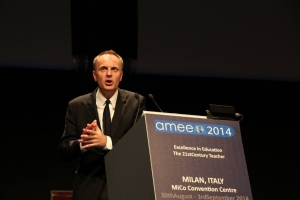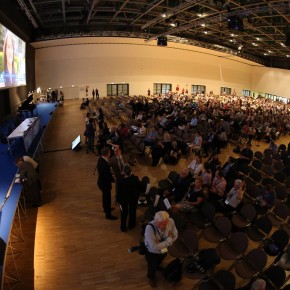In his rousing and intermittently aggressive plenary address to the thousands congregated last week at the Association for Medical Education in Europe (AMEE) Excellence in Education conference in Milan, Richard Horton bemoaned the stagnation of modern medical education, implicating everything from the ivory-tower universities of old to the world health care economy for the plummeting decline of medical education.
“Two percent of total expenditures in medicine are invested on education,” the editor-in-chief of The Lancet barked. “And that meager, pitiful amount of money jeopardizes the other 98 percent.”
The overarching theme of his talk, entitled “Meanings of Medicine: The Convergence and Crises of Civilizations,” was the dire need for physicians worldwide to reclaim and reenvision the whole of medical practice by instigating radical reforms in all disciplines.
The ultimate goal? “Health is essential to our future vision for our planet,” said Horton. “We must offer global vision for the right to health, equity and social justice.”
At the end of his address, the audience, emotionally exhausted by Horton’s much-needed speech of doom and gloom, was slow to approach the microphones for Q&A.
One gentleman asked what some of us were fervently live-tweeting (I was #3!) and certainly all of us were thinking: what is the next step?
“Students are change agents,” Horton responded emphatically.
My ears perked. That was new. At least in the United States, it’s not often that medical students are involved in meaningful conversations about the future of medical education. The relative brevity of our training, compounded by its compartmentalization into the preclinical and clinical, make long-term engagement with educators difficult for students.
And by the time I looked up from my scrolling Twitter columns, the plenary had concluded. No further discussion.
I would like to take the opportunity to finish Richard Horton’s thought, to expand upon the role of medical students as agents of change.

Richard Horton, editor-in-chief of The Lancet, gives his rousing plenary address. Photo courtesy of AMEE.
At AMEE this year, 288 medical students gathered from around the world to engage their educators in workshops, present original research, and even keep the conference running in their red polos.
In my short three-day stint at the conference, it became patently clear that those students possessed the creativity and innovative foresight necessary to become change agents.
At one oral presentation, a medical student from Thailand surveyed her colleagues and found that only 42 percent of clinic-level students were reporting occupational injuries. To tackle the problem, she designed an occupational safety curriculum and described plans to study the efficacy of the new teaching model.
Another researcher interviewed her medical student colleagues in four other European countries in an effort to characterize student perceptions of the infamous “gap year,” including challenges faced in obtaining time off from administrators.
My favorite presentation came from India, in which a student found that 54% of his colleagues reported a significant language barrier in treating their patients. His curiosity piqued, the student’s further study revealed the formation of social cliques in his class by ethnic and language groups, with significant distress brought about by state-to-state differences in culture and dress.
“In Chennai, you can wear shorts,” the student reported. “Elsewhere, only a churidar.”
And that’s not to speak of at least 25 posters studying medical student burnout and empathy lost over the clinical years, with students approaching the ubiquitous problem from every angle: mental health, medical humanities, curriculum changes, and even making comics.
All of these students identified a problem that they witnessed among their peers — or even participated in themselves — designed a way to study it, and made plans for how to change it.
Students studying students. Students changing student education. It’s an elegant and particularly powerful framework to create change in medical education.
But, let’s move to the next step: how do we engage more students in this model of peer-oriented change?
The key is to start early in medical education. As Horton stated earlier in his plenary, “The physician can be an agent for advocacy, resistance and transformational change.”
To achieve these goals as full-fledged physicians, this agency must be seeded into students early in medical education, to imbue students with a lifelong passion for advocacy and disruptive change.
I like to call this process “medicine plus” — medicine plus advocacy, medicine plus policy, medicine plus technology, any combination of fields that can be combined with medicine for the benefit of society. Advocacy can take many forms, and we must encourage students to use their training in medicine to supplement that advocacy.
The next step is directed to my fellow students: get angry.
“There is a growing sense of anger, passion that people want to translate into action,” said Horton of the medical education community in his address.
Medical students are cosmic singularities during their education, fervently consuming the vast volumes of knowledge that they are exposed to as individuals on the periphery of the care team. In that role, students are especially privy to the ills of our health care system, witnessing all of its successes and failures as a spectator looking into the arena.
By directing those pangs of moral distress at situations witnessed in the classroom or on the wards into productive study, students can become champions and change agents for their colleagues and their future patients.
Next, students must be given the freedom to experiment and to act on those passions. This step is critical, as trial and error is paramount in innovation and no change agent can be effective without successes and failures to iteratively hone their skills.
Whether it be gap years, protected research time, or facilitated learning communities, enable your students to challenge their medical education experience and work towards solutions.
Medical student experimentation has generated a number of projects important to the medical education community, including Osmosis, the Harvard Medical Student Review, and even this publication itself, in-Training.
Finally, and this one is for the students again: give your opinions freely. If there is one overwhelming theme I observed at AMEE this year, it’s that educators are starved for medical student opinions. Get on committees, send emails, write articles, keep a blog — make your interests known to the larger community.
Medical students are underrepresented in decisions that are made about our own education, and so it is our responsibility to create change for ourselves and future generations of physicians-in-training. Get your words out there, think creatively, and collaborate with your colleagues on the global stage.






